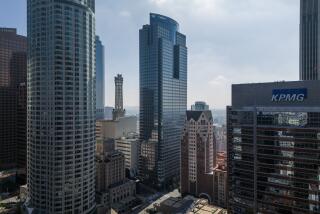Culver City to Lease Substation, Park
- Share via
The Los Angeles City Council has approved a proposal by Councilman Zev Yaroslavsky to lease the 79-year-old Ivy Substation and the adjacent two-acre Media Park to Culver City for the next 40 years.
Under an agreement between the two cities, Culver City will spend about $1 million in redevelopment funds to upgrade the park and renovate the building’s interior, leaving its shell intact. Jody Hall-Esser, Culver City community development director, said the agreement allows Culver City to withdraw from the renovation if it finds the job too expensive. She said the city would use the substation for some sort of recreational facility.
The agreement ends years of negotiations over Media Park and the two-story, brick substation, once a power station for the Red Car trolley line. Because the substation is near Culver City’s downtown business district, many thought the dilapidated structure was in Culver City. It is actually in Los Angeles.
All renovation plans will have to be approved by Los Angeles officials. Culver City also plans to improve landscaping in Media Park, which Mayor Paul A. Netzel said Los Angeles has failed to maintain.
Los Angeles had considered selling the substation in 1983 but later discovered that the building could only be leased to a public agency because the city bought it with gasoline tax revenues, according to Roberta Goldstone, a Yaroslavsky spokeswoman.
Los Angeles, which decided to retain ownership of the building and park but did not have the money to renovate them, was looking for a public agency willing to spend $1 million to refurbish both, Goldstone said. Culver City was the only interested public agency with that kind of money, she said.
“We couldn’t afford to rehabilitate it ourselves,” Goldstone said, “and we didn’t want to sell it; it’s a good piece of property.”
Media Park negotiations go back to 1963 when Culver City unsuccessfully asked Los Angeles to consider transferring jurisdiction to Culver City.
Then, in 1966, Los Angeles proposed selling the park to Culver City and using the funds to build a new park in the Palms area. The proposal didn’t go anywhere. In 1969, the city tried to sell the land to two private developers for $130,000, after failing to get its asking price of $200,000. But the sale was blocked by then-Councilman Tom Bradley, who said the city should have received the full $200,000.
A park lease agreement between Los Angeles and Culver City was proposed in 1978, but was not approved by the Los Angeles Recreation and Parks Commission until last June.
The Culver City lease took years to process because it had to go through the Los Angeles Departments of Public Works and Recreation and Parks; the Recreation and Parks and Cultural Arts commissions; the City Council’s Planning Committee and the City Council. The lease is being drafted by the Los Angeles city attorney’s office.
The Ivy Substation was once a key power station for the old Pacific Red Car trolley lines at Venice and Culver boulevards. Built in the Mission revival style in 1907, it provided power for the Pacific Railway’s Santa Monica Air Line, the Venice Short Line and the Redondo Line. The building was acquired by Los Angeles in 1977 and in 1978 was designated a historical and cultural monument by the city and placed in the National Registry of Historic Places.
In recent years, the substation has served as shelter for squatters. One of them, Phillip Rivera, a junk artist who said he has lived there for about six years, said he hopes Culver City allows him and the others to remain in the building at least through the winter.
Hall-Esser said city officials, who are aware of the transients, do not know when they will ask them to leave the building. Culver City will probably sign the lease sometime in December, she said.
More to Read
Sign up for Essential California
The most important California stories and recommendations in your inbox every morning.
You may occasionally receive promotional content from the Los Angeles Times.










